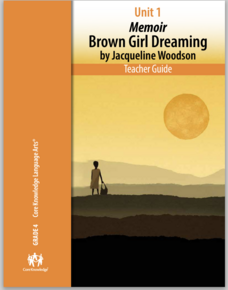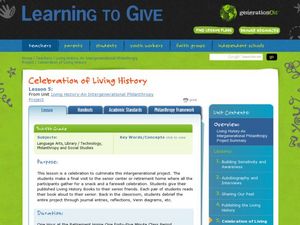Curated OER
Aztec Gods
The Aztec people had many gods in their pantheon. Your class gets to learn about three of them. They read about each of the three main gods, then create a god of their own. They use what they've learned about each god to make and...
Global Oneness Project
Documenting Architectural Heritage
Imagine going from being one of the richest, most important cities in the world to one of the poorest. Imagine the history captured in the architecture of such a city. Imagine these same now abandoned buildings being destroyed. How would...
PBS
Lesson Plan: Divided Opinions
To gain a more in-depth understanding of the tumultuous 1960s, young historians examine video clips, listen to music, examine images, and interview survivors. Once they have a foundation of information about the period, class members...
EngageNY
Grade 11 ELA Module 2: Unit 2, Lesson 6
How did the women's rights movement create a ripple effect, improving the lives of future generations? Scholars read and analyze paragraphs 11-12 of "An Address by Elizabeth Cady Stanton," in which the author emphasizes the importance of...
Curated OER
The Grandparent/Elder Project
Young scholars interview a grandparent/elder to as part of a history and writing project. In this grandparent/elder project lesson, students record an interview of an older person who is willing to share their past. They look at pictures...
Curated OER
Objects Then and Now
What ancient Roman objects perform the same tasks as modern objects? In this worksheet, students are asked to identify 5 illustrations of Roman objects. Kids are then prompted to compare these objects with the functions of 5 modern...
New York State Education Department
TASC Transition Curriculum: Workshop 11
You'll C-E-R a difference in classroom achievement after using a helpful lesson. Designed for economics, civics, government, and US history classes, participants practice using the CER model to craft arguments about primary and secondary...
Library of Congress
To Kill A Mockingbird: A Historical Perspective
Students study the novel, To Kill a Mockingbird. Through studying primary source materials from American Memory and other online resources, students of all backgrounds study the relationships between blacks and whites.
Curated OER
King Arthur and his Knights
Fourth graders examine the myths of King Arthur. They compare/contrast versions of the story, The Sword in the Stone, write a letter, identify and analyze characters, sequence events, and write observations and answer questions in a...
Curated OER
Why Do We Remember Revere? Paul Revere's Ride in History and Literature
Students examine primary documents regarding Paul Revere's ride and its role in the Revolutionary War. They consider how Revere's role has been written about by Longfellow and others and discuss the discrepancies between accounts.
Core Knowledge Foundation
Unit 1: Memoir - Brown Girl Dreaming by Jacqueline Woodson
The memoir, Brown Girl Dreaming by Jacqueline Woodson, is the focus of a unit designed for fourth graders. Scholars begin each lesson with a warm-up, then listen to a read-aloud of a section of the book. Pupils complete word work,...
Core Knowledge Foundation
Unit 1: Contemporary Fiction - They Call Me Güero: A Border Kid’s Poems by David Bowles
They Call Me Güero: A Border Kid's Poems by David Bowles is the focus of a five-week language arts unit unit. Fifth graders listen to various poems and participate in thoughtful discussions, examining vocabulary and learning new words in...
Annenberg Foundation
Utopian Promise
Scholars learn all about the Puritans in the third installment of a 16-part lesson series. After watching a video, they read and discuss biographies of Puritans and Quakers from American history, write journal entries and poetry, and...
NPR
Civil Rights of Japanese-American Internees
Prompted by a viewing of Emiko and Chizu Omori’s Rabbit in the Moon, a documentary about the internment of Japanese-Americans during World War II, high schoolers examine a series of documents, including the Bill of Rights and the UN’s...
Curated OER
Lesson: Before You Go...Travel Recommendations from the Experts!
Here is a lesson that sounds like a lot of fun. Kids discuss the artistic elements and motives for the painting, Grand Canyon of the Yellowstone. To get the scope and scale of this oversized masterpiece, they use butcher paper and the...
Curated OER
Through the Looking Glass
An engaging and ambitious series of four lessons invites high schoolers to view art work, have group and class discussions, construct time lines, compile photos, and conduct research. Learners share their experiences, create...
Curated OER
Lesson: Differing World Views: Human and Animals
Kids challenge their understanding of the world around them and consider the impact man has on the environment and animal life. They examine a Tlingit piece, read two Tlingit stories about man and animals, then participate in a research...
Curated OER
Viking History
Young scholars learn about the history of the Vikings by watching videos, reading books, and writing journal entries pretending they were Vikings. For this Vikings lesson plan, students also make a long ship out of a milk carton.
Curated OER
Ancient Greece: Inquiring Minds Want to Know
Second graders explore world history by writing newspaper articles. In this Greek history lesson, 2nd graders investigate the geography and society of Ancient Greece by utilizing the Internet as a research tool. Students collaborate with...
Curated OER
Celebration of Living History
Students create a living history book about themselves and read it to a senior friend. In this living history lesson plan, students complete a project about the living history of their lives by filling out venn diagrams and sharing it...
Curated OER
Who Were the Dissidents?
Students discover how Japanese dissidents spoke out against the injustice practiced in Imperial Japan. In this Japanese history lesson, students listen to a lecture about the silent dissidents in the nation prior to World War II and the...
Curated OER
Putting the Truth in Writing
Learners define "nonfiction" and describe what they view as the best pieces of nonfiction writing. They determine criteria to evaluate whether or not a piece of nonfiction writing is good, and list categories of nonfiction writing.
Curated OER
Email Writing
Students review rules of writing emails for letters, informal to a friend and formal. In this writing lesson, students sort email strips into these categories and then review examples of good and bad semi-formal emails. Students work in...
Curated OER
Timeline of Ancient Africa
In this ancient Africa worksheet, students complete a timeline and respond to 4 short answer questions about the civilizations of Egypt, Ghana, Kush and Mali.

























